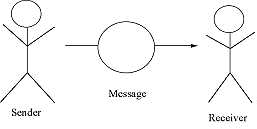
As film makers, artists and enthusiasts, we hold cinematic work in high esteem. We search for meanings, analysis, techniques and their effects while enjoying one of the most complex art forms. In classical days (before the 1960's) film could be analyzed as discreet units (frame, shot or the scene) with bounded understanding of the artistic whole. Alternately, the analytical techniques of literature and drama could be applied (with suitable augmentation) for results not always suitable for the necessary feedback for artistic growth. Auteur Theory appears to approach a work as a triumph of an artist over his material. The personal motifs and signatures are amplified to a point of exaggeration. The focus had left the work for the creator. The theory of film evolved back to concentrating on the film itself with the introduction of the first and second semiotics. A language of cinema is proposed which places film on a more scientific basis. The work of Christian Metz is the basis of this semiotics. From this basis enhancements based on symbols, linguistics and psychoanalysis are introduced. Current advances seem to focus on the spectator. What is perceived? Can a film represent a true feeling of a minority. So for thirty years we have pulled our theoretical attention from the creator, to the product, to the consumer. Has all of this activity given us a general approach to film? Perhaps so. This paper is an attempt to formulate a theory of film based on the modern film theories and basic communication theory.
If we look at communication in its pure and basic form we have a three element model: Sender, message, receiver. The sender sends a message which is received by the receiver totally. There is a complete one-to-one correspondence of the sent message and the received message.

Unfortunately, we do not live in a perfect world, therefore it is normal for the receiver to not only receive the message but noise as well. The noise may hamper the receiver from receiving the total message. This leads us to a model that is no longer in balance.
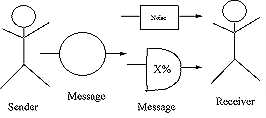
Our purpose is not to develop a theory of communications or even linguistics but one for film. The theory is based on the communications model and the theories mentioned previously. The sender is assumed to be an Auteur, the message a text and the receiver a spectator.
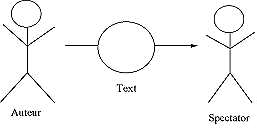
From the 'Theory of Auteurism' we draw a purpose in defining the Auteur not in the pure traditional sense (although compatible) but in terms of semiotics. The purpose is two fold: to understand the creator of the text, and eliminate the trivial from our discussion. The Auteur is a prophetic craftsman, a distinguishable personality and a creator of inner meaning. Andrew Sarris describes 'the Auteur theory emphasizes the body of a director's work rather than isolated masterpieces'. The Auteur theory is a classification system describing the Auteur and his collective work.
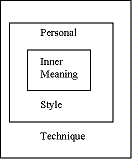
If we draw on the theory of semiotics we can further articulate the Auteur and his work. Christian Metz describes two categories (or axis) of cinematic text. the first is the syntagmatic or the narrative line. 'it is the syntagmatic considerations that are at the center of the problems of film's denotation. Although each image is a free creation, the arrangement of these images into an intelligible sequence - cutting and montage - brings us to the heart of the semiological dimension of file.'
The other being the paradigmatic or symbolic axis. Umberto Eco describes the language of the paradigmatic category. 'It carries preexisting codes and it is carried by its own specific codes. Sometimes it establishes new codes and often these new correlations produced by a given film will not be accepted by cinema.'
Thus an Auteur must work on both'
Thus an Auteur must work on both the Paradigmatic and Syntagmatic axes even if it is purposely to ignore one or the other.
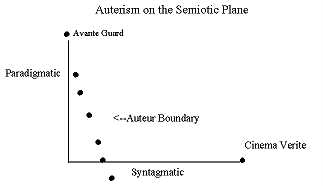
It is important to describe the Auteur and his work in the light of Auteurism in order to assess the intended text communicated. The complexity of film is such that it is possible to receive a text dramatically different from the one sent. By understanding the Auteur we hold a better chance of receiving the intended text.
The term text is used to describe a set of images (video or audio) that create a message (or even an inner meaning). The concept of text is hierarchical where a high text can be composed of lower texts (and possibly augmented with images). For example in Fellini's 8 1/2 we have a text concerning the pomp and oppression of the church of Rome. This text is made up of other texts: the interview with the cardinal, the preinterview discussions, the parade of clergy and the punishment for indiscretion with the fat lady. Each text is a text on its own and contributes to a greater text.
Texts come in many forms, the study of these forms falls back to the disciplines of dramatic, artistic and literacy criticism augmented with an understanding of montage and the film theories of Kracauer and Bazin.
To use the semiotic model to exemplify some of the possible textual analysis we look at text on the syntagmatic axis:
Direct Text: image without symbolic interpretation.
example: the policeman returns Orphan Annie to Miss Hannagan after she ran away from the orphanage. (Houston's, Age. (Houston's, Annie).
Mediated Text: an interpretation of the text is presented.
example: Alex explains in A Clockwork Orange 'This is the real weepy and tragic part of the story beginning now, oh my friends' (Kubrick's A Clockwork Orange).
Complementary Text: presentation of the negative.
example: The song 'If You Could See Her Through My Eyes' she wouldn't look Jewish at all (Fosse's, Cabaret).
The techniques for storytelling are varied and elaborate, it is enough to say that the codification can be completed where the detail is necessary.
The paradigmatic axis offers further classification and cross reference. In the case of symbolism the book is still open on ways of representing images. Thus we can build texts on the paradigmatic axis with symbolic images (video or audio).
example:
Thus we have a system of placing a text on the semiotic plane by evaluating its narrative and symbolic qualities.
Now, there is an additional concept ties.
Now, there is an additional concept that links back to the Auteur. The intent can be intended (IT) (by deliberate design of the Auteur) or unintended (UT) (perceived but not part of the design of the Auteur). The intended text is like the message while the unintended text is noise.
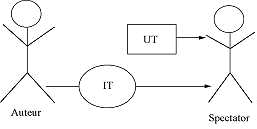
Modern thought places importance on the spectator as a vital part of the film process. The psychological and social basis of film are noted to place the film on an individual basis with the spectator. Psychology is usually based on Freudian ideas expounded by the feminist critics while the social analysis draws on Marxist notions of ideology and structure.
This approach to a film places the spectator at the position of the camera. From this vantage point, he is an act of perception. He is the privileged voyeur who is safe to witness the incredible and unthinkable.
Laura Mulrey takes the psychoanalytical approach, further by labelling the act of witnessing as 'Visual Pleasure'. This is based on the concept of viewing another as an erotic object. Another pleasure is invoked by vicariously identifying with the male character who is in control. Finally, the image of women can be threatening when representing a castrated being. Lucy Fischer points out that females can view these male texts, t that females can view these male texts, enjoy them but have limited room for positive identification.
To believe that females are the only people with limitations for identification would be naive if not bigoted. Film makers of racial minorities (Britain) are exploring the craft to create a cinema with a higher affinity to their minority audience. Criticism of this work is founded on Marxist philosophies. The need to reject many of the symbols and conventions of cultural imperialism gives justification for texts previously rejected. The rules are written once again.
Spectator can react in one of four ways:
To quantify the ability to and likelihood of a reaction the following profile analysis is offered as a model:
If the spectator has no common areas with the film then he will neglect the film. If the common areas are in opposition then he will reject the film. If the common areas are similar then he will accept the film. Finally, if the common area are opposed and similar then a negotiation with the film can take place.
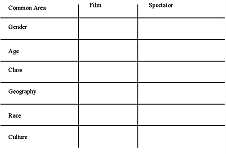
To illustrate the evaluation process the author of this paper is the sample spectator against four films.
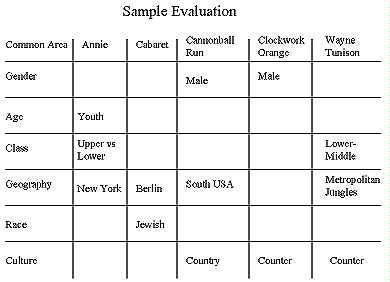
As a spectator I could accept Cabaret and A Clockwork Orange, neglect Cannonball Run and negotiate with Annie. To negotiate a reading of the film Annie may seem unbelievable but yet it is true. The upper class heart toward clean little Annie was overpowering the slight interest in New York geography that I had. My young daughter forced repeated viewings on me until I not only appreciated the music but much of the text. To me this was a perfect example of the negotiation described by Homi K. Bhabha: "the act of negotiation will only be interrogatory. Can such split subjects and differentiated social movements, which display ambivalent and divided forms of identification, be represented in a 'collective will' .... How does the language of the will accommodate the vicissitudes of its representation, which is its construction through a symbolic majority where the havenots identify themselves from the position of the haves?".
So what could have been a rejected film becomes negotiated acceptance.
The problem facing the spectator is the accuracy that he receives the texts. When the common areas are in opposition there is a tendency to receive texts (UT) rather than the intended (IT).
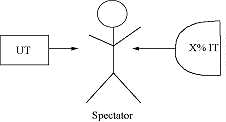
When the common areas are not similarly matched, the capture ratios (X%) drops.
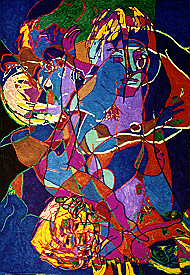
|
"THE" Collaborative Process |
|||||||
| (September 96 - April 97) | ||||||||
| Lies | Saints | Addictions | Handcuffs | Evolution | ||||
| Video | Rituals | Humour | Violence | Sanctity | ||||
| Page Last Updated July 4, 2000 | ||||||||
| Contribute and Win a Jazzsuite. | ||||||||